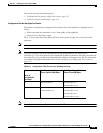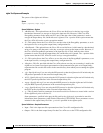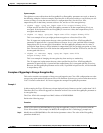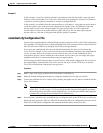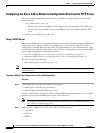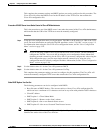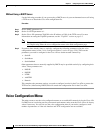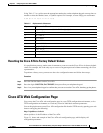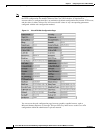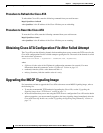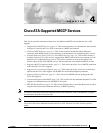
3-20
Cisco ATA 186 and Cisco ATA 188 Analog Telephone Adaptor Administrator’s Guide for MGCP (version 3.0)
OL-4803-01
Chapter 3 Configuring the Cisco ATA for MGCP
Voice Configuration Menu
Without Using a DHCP Server
Use the following procedure if you are not using a DHCP server in your environment but are still using
a TFTP server to obtain the Cisco ATA configuration file:
Procedure
Step 1 Set the DHCP parameter to 0.
Step 2 Set the UseTFTP parameter to 1.
Step 3 Set the Cisco ATA parameter TftpURL to the IP address or URL of the TFTP server. For more
information on setting the TftpURL parameter, see the “TftpURL” section on page 5-5.
Note If you are not using a DHCP server to provide the TFTP server location, you must manually enter
the TftpUrl using either the voice configuration menu or the Web configuration page.
Step 4 If you have done already done so, statically configure the following parameters using the voice
configuration menu (see the “Voice Configuration Menu” section on page 3-20). These are the
parameters you need to configure for the Cisco ATA to obtain network connectivity:
• StaticIP
• StaticRoute
• StaticNetMask
Other parameters that are normally supplied by DHCP may be provided statically by configuring their
values. These parameters are:
• DNS1IP
• DNS2IP
• NTPIP
• AltNTPIP
• Domain
This completes the parameter settings you need to configure in order for the Cisco ATA to contact the
TFTP server (without using DHCP) that will contain the configuration file for the Cisco ATA.
Voice Configuration Menu
The main reasons to use the voice configuration menu are to establish IP connectivity for the Cisco ATA
if a DHCP server is not being used in your network environment, and to reset the Cisco ATA to its factory
values if necessary. You can also use the voice configuration menu if you need to configure a small
number of parameters or if the web interface and TFTP configuration are not available.




